Intel Core i9-13900K and i5-13600K Review: Raptor Lake Brings More Bite
by Gavin Bonshor on October 20, 2022 9:00 AM EST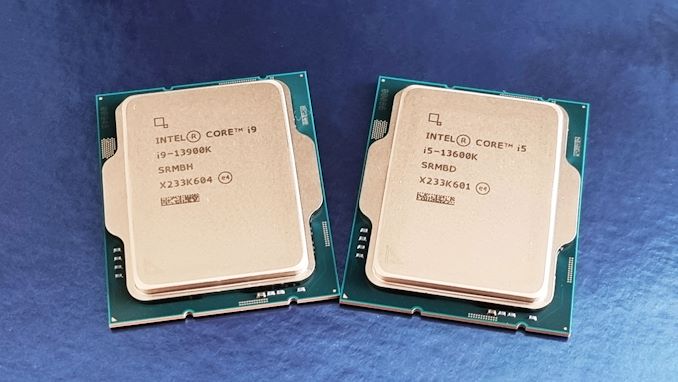
Today marks the release of Intel’s 13th generation Core processor series, codenamed Raptor Lake. The first models to be unleashed into retail channels are all overclockable parts, with six SKUs across the Core i9, i7, and i5 product segments. We’ve seen Intel’s heterogeneous or hybrid design with the launch of Intel’s Alder Lake (12th Gen Core) products, and the latest Raptor Lake core brings a very similar design to the table, but with subtle improvements designed to help give Intel the leading edge in the desktop market.
The launch of Intel's new lineup is essentially the second half of this fall's desktop CPU releases. AMD got the first word in a few weeks back with the launch of their Ryzen 7000 desktop processors, which introduced the Zen 4 architecture as well a significant platform update for AMD with Socket AM5. The new high-end Ryzen chips were well-received (if a bit expensive), setting a new bar for performance and putting AMD firmly into the lead, at least for a little bit. Now it's time for Intel's own CPU launch – their rebuttal – where they get to show off what they've been working on over the past few years and whether they can retain their edge over AMD for this latest generation of processors.
At a high level, Raptor Lake can be thought of as a mid-cycle upgrade of sorts for Intel’s current LGA-1700 platform. As the company launched Alder Lake and LGA-1700 just a year ago, they aren’t looking to overhaul the core CPU architecture quite so soon, nor the platform for that matter. Intel is keeping to their two-year platform cycle here, so the 13th generation of Core processors are designed to bring more performance to the same platform as Alder Lake. This makes the Raptor Lake launch significantly more straightforward than AMD’s recent launch, where AMD overhauled their entire platform while also making some more significant CPU architecture upgrades in the process.
Because Intel isn’t significantly tweaking their CPU architectures for Raptor Lake, the chip is essentially a refined version of Alder Lake. That means we’re still looking at a mixture of P(erformance) and E(fficiency) CPU cores, based on different CPU architectures and designed to allow Intel to hit high performance levels in both single/light-threaded workloads that favor the P cores, and heavily multi-threaded workloads that can also saturate the E cores. The P cores are based on what’s technically a new architecture, Raptor Cove, while the E cores are still based on the same Gracemont architecture as what we saw on Alder Lake.
We’ll dive into the internal bits of Raptor Lake a bit later on, but at a high level, Intel is improving performance versus Alder Lake in three ways.
- Higher clockspeeds, especially for the P cores, thanks to some architectural optimization work combined with further refinements of the Intel 7 fab process
- Additional E cores in all desktop SKUs, to boost performance in multi-threaded workloads
- Additional L2 cache for both the P and E cores. The L3 cache is also a bit larger, primarily to accommodate the larger number of E cores.
The higher clockspeeds and additional cache mean that Raptor Lake should be faster in virtually all scenarios compared to Alder Lake. For single-threaded and lightly-threaded workloads, the faster P cores can chew through work. Meanwhile the full combination of additional E cores and higher clockspeeds means that multi-threaded performance often shows even greater gains.
Raptor Lake will, in time, be a top-to-bottom launch for Intel and its partners. That means not only launching desktop processors, as we’re seeing the first of today, but also a complete stack of mobile parts, with U, P, H, and HX series processors all planned. And while mobile parts are a bit trickier with regards to adding clocks and cores while staying within a power budget, Intel’s design optimizations can also be used to improve energy efficiency instead, which will be of greater importance for the mobile market.
Starting At the Top: Core i9-13900K, i7-13700K, and i5-13600K
But to start things off, let’s talk about today’s launch. Intel has opted for a top-to-bottom, desktop-to-mobile launch strategy, pulling the trigger on its overclockable desktop parts first. This is typical of Intel's recent desktop launches, and allows them to get their relatively lower volume desktop chips out first while continuing to ramp for higher volume desktop and mobile parts. Altogether Intel is launching 3 tiers of chips spread over 6 SKUs, all overclockable (K) and coming either with and without (F) integrated graphics.
| Intel 13th Gen Core, Raptor Lake | ||||||||||
| AnandTech | Cores P+E/T |
P-Core Base |
P-Core Turbo |
E-Core Base |
E-Core Turbo |
L3 Cache (MB) |
IGP | Base W |
Turbo W |
Price ($) |
| i9-13900K | 8+16/32 | 3300 | 5800 | 2200 | 4300 | 36 | 770 | 125 | 253 | $589 |
| i9-13900KF | 8+16/32 | 3300 | 5800 | 2200 | 4300 | 36 | - | 125 | 253 | $564 |
| i7-13700K | 8+8/24 | 3400 | 5400 | 2500 | 4200 | 30 | 770 | 125 | 253 | $409 |
| i7-13700KF | 8+8/24 | 3400 | 5400 | 2500 | 4200 | 30 | - | 125 | 253 | $384 |
| i5-13600K | 6+8/20 | 3500 | 5100 | 2600 | 3900 | 24 | 770 | 125 | 181 | $319 |
| i5-13600KF | 6+8/20 | 3500 | 5100 | 2600 | 3900 | 24 | - | 125 | 181 | $294 |
Compared to the relevant 12th Gen Core SKUs, Intel has replaced the P cores with new Raptor Cove cores on a 1:1 basis. Meanwhile for the E cores, Intel has effectively doubled the number of E cores for each corresponding SKU. e.g., the Core i5-13600K now has eight E-cores whereas the Core i5-12600K had four. Otherwise, TDPs remain unchanged from the previous chips, with Intel officially targeting 125W – though PL2 limits have crept up from 241W to 253W.
Focusing first on the flagship chip, the Core i9-13900K has an incredible max P-core turbo of 5.8 GHz. This is an increase of 600 MHz over the Core i9-12900K. Although it has the same performance core count as its predecessor (though with Raptor Cove cores), it now features double the efficiency cores; a total of 24 hybrid cores comprised of 8P and 16E cores. This makes for eight more threads, for a total of 32, up from 24 on the Core i9-12900K.
One thing to note about the efficiency cores is that Intel has lowered the base frequency of these cores to 2.2 GHz base, which is down from 2.4GHz on Alder Lake. But at the same time, however, they have also increased the E-core max turbo clockspeed to 4.3 GHz, 400Mhz higher than the 3.9 GHz cores on Alder Lake.
Intel has made similar trade-offs across all of its 13th Gen Core SKUs – so this isn’t just the case for the i9 parts, but also the i7 and i5 parts as well. Ultimately while Intel would ideally like to run the E cores at their highest clockspeeds at all times, the expanded number of cores makes it harder to stay within Intel’s official 125W TDP, necessitating a reduction on the base clockspeeds.
Moving down the stack, the Core i7-13700K and KF processors both have a total of sixteen CPU cores (8P+8E), which is up from 8P+4E on the Core i7-12700K. For these parts the maximum P-core turbo clockspeed is 5.4 GHz, while the P-core base clockspeed stands at 3.4 GHz.
Finally, filling out the i5 spot in Intel’s lineup is the Core i5-13600K, which we will also be testing today. The 13600K parts come with a total of fourteen cores in 6P+8E configuration, four more cores than on the Alder Lake i5-12600K. Both the Core i5-13600K and i5-13600KF feature a P-core max turbo of up to 5.1 GHz (up from 4.9 GHz), and an E-core turbo of up to 3.9 GHz (up from 3.6 GHz).
Z790 Chipset & DDR5-5600 Support
The launch of the 13th Gen Core chips also comes with a new generation of motherboards from Intel: Z790. As noted earlier, the 13th Gen Core chips are backwards-compatible with 600 series boards (with the necessary BIOS update), so they can be used as a drop-in upgrade or as part of a fresh built. But for builders looking for the best – or even just guaranteed CPU compatibility out of the box – Intel is hoping to entice you with Z790.
Like the rest of the Raptor Lake platform, Z790 is not a significant overhaul of Intel’s existing wares. But Z790 does offer perks. Most notable for aspiring builders will be that Z790 boards will be the first boards validated for the higher DDR5 memory speeds that Raptor Lake is capable of. Whereas Alder Lake officially topped out at DDR5-4800, Raptor Lake can run at DDR5-5600, helping to feed the beast a bit more with higher memory clockspeeds. Enthusiasts will likely run overclocked with XMP kits, but for anyone building systems to spec – be it OEMs or individual builders – this is a nice bump in bandwidth. Meanwhile it should be noted that there’s nothing stopping existing Z690 boards from being validated for higher speeds as well, but that will be up to motherboard manufacturers running a fresh round of validation with the new Raptor Lake chips.
As for the Z790 chipset itself, it brings a bit more I/O flexibility compared to Z690. Z790 now sports 20 PCIe 4 lanes, versus 12 on Z690. That’s augmented with 8 PCIe 3 lanes, 8 fewer than on Z690. Z790 also brings support for one more USB 20Gbps (USB 3.2 Gen 2x2) port than its predecessor, making for a total of 5.
Sizing Up the Competition: 13th Gen Core vs. Ryzen 7000
With Intel’s shift to a heterogeneous CPU architecture, like-for-like comparisons between Intel and AMD have become a little harder. None the less, as AMD and Intel have evolved to have similarly-named product stacks – and for that matter similar pricing – it’s not too hard to line up what chips are primarily in competition with each other.
| Raptor Lake Competition | |||||||
| AnandTech | Core i9 13900K |
Core i5 13600K |
Core i9 12900K |
Core i5 12600K |
Ryzen 9 7950X |
Ryzen 5 7600X |
|
| uArch | Raptor Cove + Gracemont |
Raptor Cove + Gracemont |
Golden Cove + Gracemont |
Golden Cove + Gracemont |
Zen 4 | Zen 4 | |
| Cores | 8P + 16E 32 T |
6P + 8E 20 T |
8P + 8E 24 T |
6P + 4E 16 T |
16 C 32 T |
6 C 12 T |
|
| Base Freq (P) | 3300 | 3500 | 3200 | 3700 | 4500 | 4700 | |
| Turbo Freq (P) | 5800 | 5100 | 5200 | 4900 | 5700 | 5300 | |
| TDP | 125 W | 125 W | 125 W | 125 W | 170 W | 105 W | |
| PL2/PPT | 253 W | 181 W | 241 W | 150 W | 230 W | 142 W | |
| iGPU / Cores | Xe-LP, 32 | Xe-LP, 32 | Xe-LP, 32 | Xe-LP, 32 | RDNA 2, 2 | RDNA 2, 2 | |
| L3 Cache | 36 MB | 24 MB | 30 MB | 20 MB | 64 MB | 32 MB | |
| DDR5 | 2 x 5600 | 2 x 5600 | 2 x 4800 | 2 x 4800 | 2 x 5200 | 2 x 5200 | |
| CPU PCIe | 5.0 x16 + 4.0 x4 |
5.0 x16 + 4.0 x4 |
5.0 x16 + 4.0 x4 |
5.0 x16 + 4.0 x4 |
5.0 x28 | 5.0 x28 | |
| MSRP | $589 | $319 | $589 | $289 | $699 | $299 | |
At the high-end, Intel is going up against AMD’s flagship with fewer P cores (or their AMD equivalent), but is augmenting that with a much larger number of E cores. As a result Intel has more CPU cores to offer overall, but the performance implications are very workload dependent. The 13900K shines on tasks that can fill all 24 cores/32 threads, and ideally can account for the difference in performance between the core types. Otherwise, AMD offers fewer total cores, but more performance on a per-core basis when 9 to 16 cores are needed.
In Intel’s favor is a lower CPU cost ($589 vs. $699), as well as official support for faster DDR5 memory (and DDR4, if you need it). Whereas AMD offers more I/O flexibility with up to 28 PCIe 5 lanes coming from the CPU, as well as a larger overall L3 cache.
Meanwhile at the other end of the spectrum, the bottom of the stack for the two companies is brought up by the i5-13600K and Ryzen 5 7600X. The Intel chip offers 6 Raptor Cove P cores to AMD’s 6 Zen 4 cores, and then Intel added 8 E cores on top of that. But in this case Intel no longer has the price advantage, as the 13600K is $20 more expensive than its AMD competition. This gives Intel a potentially large advantage in multi-threaded workloads, though for fewer threads, AMD does have a bit of a clockspeed lead.
- Intel Core i9-13900K and i5-13600K Review: Raptor Cove, What's New?
- Raptor Lake In Detail: Raptor Cove P-Cores, More Efficiency Cores
- Z790 Chipset: More I/O Than Z690, But Same Performance
- Test Bed and Setup: Updating Our Test Suite for 2023
- Core to Core Latency
- SPEC2017 Single-Threaded Results
- SPEC2017 Multi-Threaded Results
- CPU Benchmark Performance: Power and Office
- CPU Benchmark Performance: Science
- CPU Benchmark Performance: Simulation
- CPU Benchmark Performance: Rendering And Encoding
- CPU Benchmark Performance: Legacy Tests
- Gaming Performance: iGPU
- Gaming Performance: 720p and Lower
- Gaming Performance: 1080p
- Gaming Performance: 1440p
- Gaming Performance: 4K
- Closing Thoughts


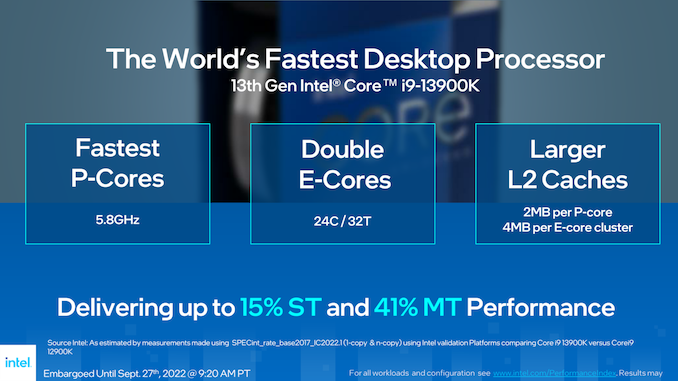
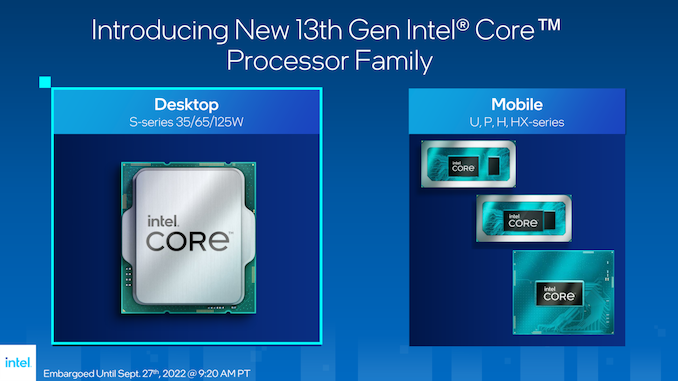
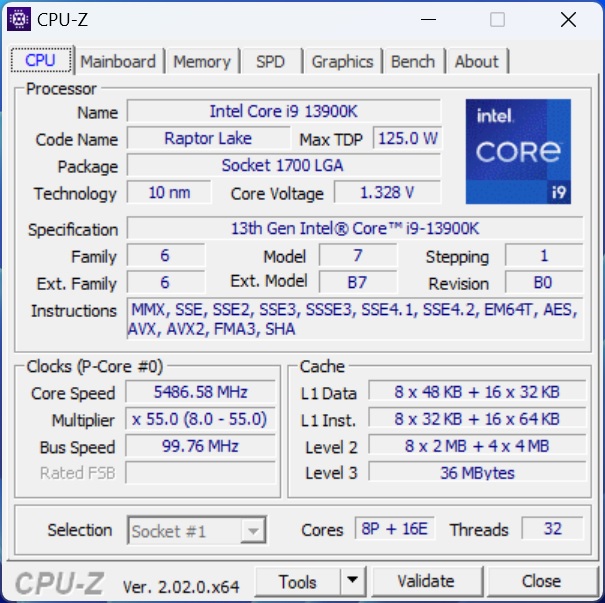
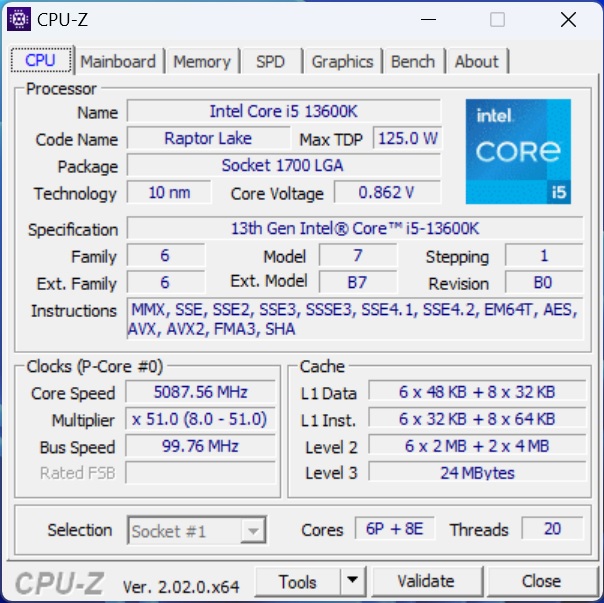
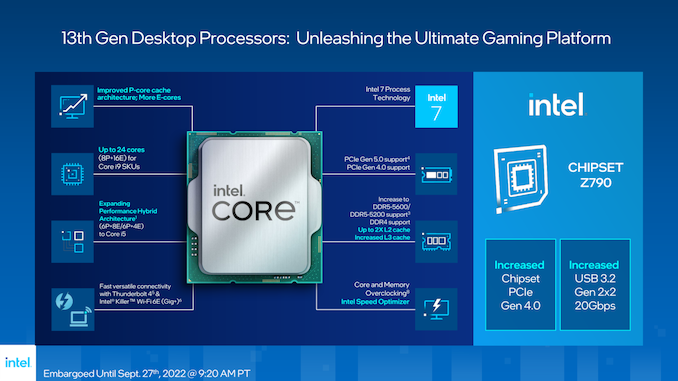








169 Comments
View All Comments
Bruzzone - Friday, October 21, 2022 - link
Raptor ask first day in the open market;13900K = $845 + 43% over i$1K
13900KF = $1187 + 110%
13700K = $393 (-12.5%) some assemblance of reality in the world
13700KF = $415 + 8%
13600K = $393 + 23%
13600KF = $415 + 34%
Raphael R7K fifth week of supply open market;
7950X = $933 + 33.6%
7900X = $695 + 26.6%
7700K = $477 + 19.5%
7600X = $422 + 41.3%
In July Intel signaled a +20% price increase and AMD ignored Intel counsel and the channel will settle that question by Black Friday Cybor Monday. The question has already been answered for dGPU in the market for RTX 4090?
mb Reply
Wrs - Friday, October 21, 2022 - link
That's why I usually buy new hardware a bit after Xmas. That wouldn't have worked for several reasons in 2020-21, but other years it's served me well. ReplyBruzzone - Friday, October 21, 2022 - link
Prior gen CPU and dGPU production overage run end absolutely a "bit after Christmas".New primary dGPU a Pareto distribution curve and that does not explain it the situation assessment fully for all consideration.
On new CPU production AMD ignoring Intel + 20% price increase offer it's a CPU new primary price war unless the channel disagrees bringing normalcy to cost : price / margin assessment on cost : price / margin realities.
mb Reply
Ryan Smith - Thursday, October 20, 2022 - link
Like any other CPU launch, the only prices we have at the start are the prices provided by the manufacturers. Retail prices can and will vary, especially at the very start when chips are in short supply.It's best to consider it guidance rather than hard numbers. Reply
allenb - Thursday, October 20, 2022 - link
Now this is what we want to see! Proper, vicious, dog-eat-dog competition from Intel and AMD. I've rarely seen a clearer example of why competition is good and entrenched monopolies (or near monopolies) are bad. Hats off to both competitors. ReplyOxford Guy - Friday, October 28, 2022 - link
Duopoly is hardly adequate competition. ReplySilver5urfer - Thursday, October 20, 2022 - link
I will keep it short.Buy Intel get it under AIO and get ready for 340W load on 13900K while AMD Zen 4 is at 95C but its significantly lower power at 230W only max. The flagship parts need AIOs no Air coolers, but with AMD some of the Air coolers can work without problem since the heat is only factor but not the high power as the Temp target can be set on AMD platform from 95C to 92C. Intel 12900K and up aka 13700K, 13900K cannot be tamed on Air coolers esp when you tune them. So a mild win to AMD.
The I/O is a win for Intel due to DMI is 4.0x8 while X670E is PCIe4.0x4 like X570 bummer from AMD perhaps PCIe5.0 redrivers and layers cost.
IMC wise Intel is winning, but with DDR5 in this infancy stage even buying 7000MHz low Latency DRAM won't benefit RPL at all. AMD stuck to 6000MHz EXPO why did you not review on that ? I think AT should have stuck to XMP for Intel and EXPO for AMD as AMD will have better performance with better DRAM since the Zen 2 days. Ultimately IMC is bragging right for Intel DDR5 RPL now, the socket is EOL and you cannot install new Kits and expect magic just like 8th gen vs 10th gen IMCs you will need a new Chip.
Socket is dead end for Intel nothing extra is coming, you are locked out. AM5 will get Zen 4D and Zen 5 and 5D as well. Much better longevity past 2025+ if AMD launches Zen 6 then it's insane on this AM5 socket. Also Z790 will have CPU socket bending issues note that as well.AMD wins here.
Performance wise, both are neck to neck. High clocks on both high MT workloads on both camps, this is very interesting market for R9 and i9 parts. Coming to i5 and R5 parts, Intel has more performance but AMD has better pricing. However the most parts shipped will be this range only I think Intel may win more Client sales vs AMD due to DDR4. No winner but it's a great consumer choice. One point to note, AMD has higher Base Freq vs Intel this means better performance for AMD on all workloads and not just demanding. Esp with Zen 4 which is a solid chip than Zen 3 with it's lower clocks annoying IOD crapping out and IMC being subpar.
AVX512 is dead, big shame to Intel. They are wasting 30% of the die space in the RPL processors P cores, ultimate pathetic move. AMD is a champion with dual AVX256 making it solid no AVX offset performance unlike Intel 11th and 12th gen. AMD wins here. Reply
WaltC - Thursday, October 20, 2022 - link
I hope this sad excuse from Intel shuts the facial orifices of those who thought the power draw of the 7950X was "too high"...;) These CPUs should sell well in colder climes, no doubt (for people who can afford the power bills...;)) ReplyWrs - Friday, October 21, 2022 - link
For workload efficiency it's mainly about the process tech. AMD with TSMC are at 5nm, Intel is still at 7nm (or you can say TSMC is around Intel's 7nm, while Intel is using its 3rd-gen 10nm).I like my P-cores on 12900k, thank you, they are the reason I didn't stick with Zen 3. A desktop computer needs to be highly responsive and it needs throughput when called for. I weigh those as 50% ST:50% MT, but everyone should personalize their ratio to what they really do. 90% ST:10% MT? Get a laptop. 10% ST:90% MT? A workstation or remote server/cloud.
I also have no issue with a D15 air cooler. The processor automatically tamps down to 250W sustained, but if I want something intense done, it'll blitz through the first second or two. As for power bill considerations, the Zen 3 did idle pretty high and I noticed. But on my desktop I rarely ever idle. It was more that a year ago, Zen 3 and Alder Lake were the same process generation, and Alder Lake hands down won the ST. Reply
yh125d - Thursday, October 20, 2022 - link
So top of the line Raptor Lake trades blows/equals on average to Zen 4. But only if you have a motherboard/cooler capable of delivering and cooling 300+w, which means top of the line hardware. By the time you factor in the cost of a top notch MB and 360 AIO, you erase the price advantage of the processor itself.Limit i9 to similar power levels, and the performance would reduce more than just a few % I'd wager, so for those sticking with air cooling or smaller AIO's, Zen 4 has a clear advantage. This also points out that Raptor Lake doesn't have much headroom above this to go, where Zen 4 (if allowed 250w+) would clearly outperform RL at same power levels
Overall, this generation is much closer than I'd thought it would be, which as always is great for consumers Reply